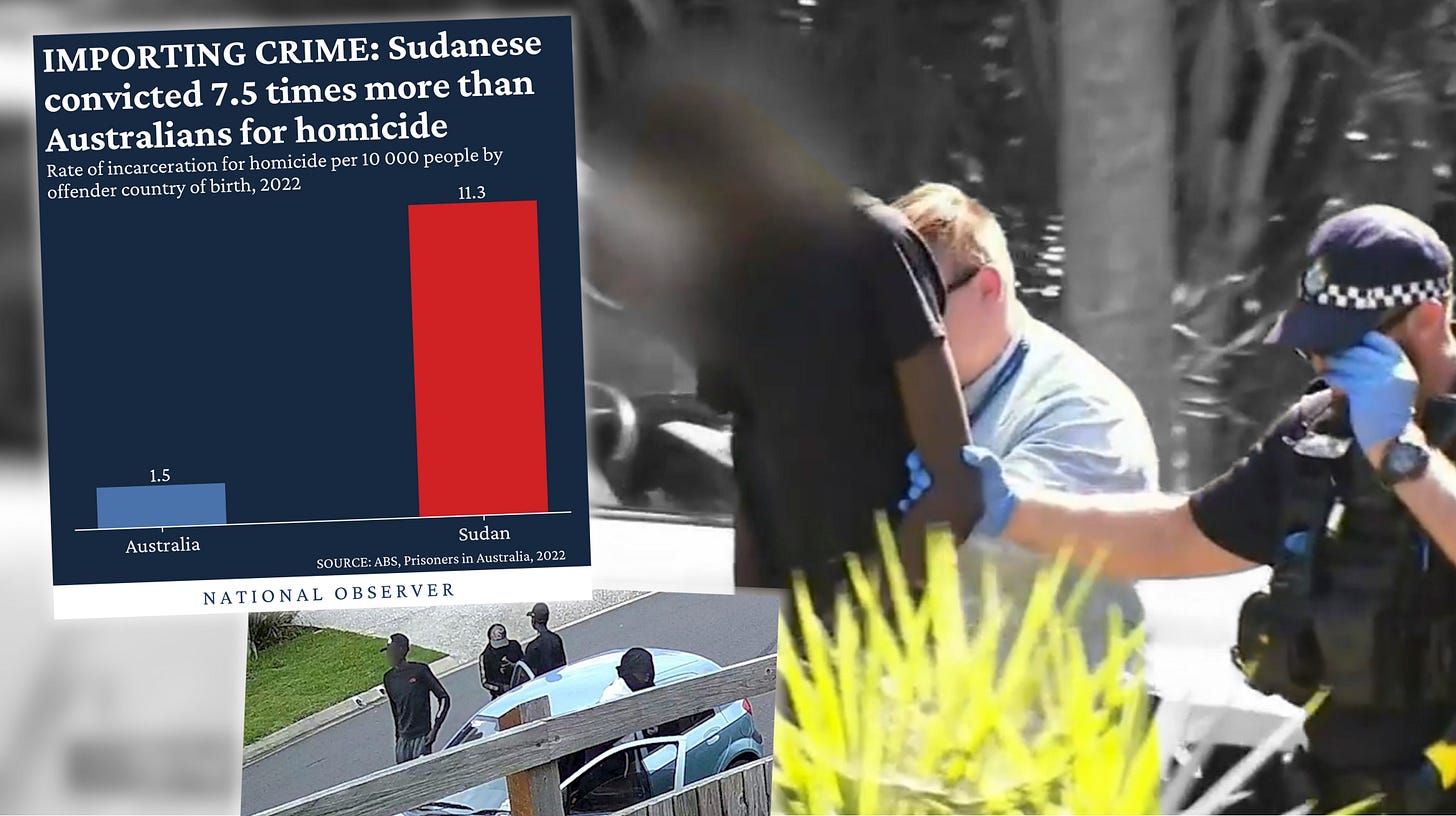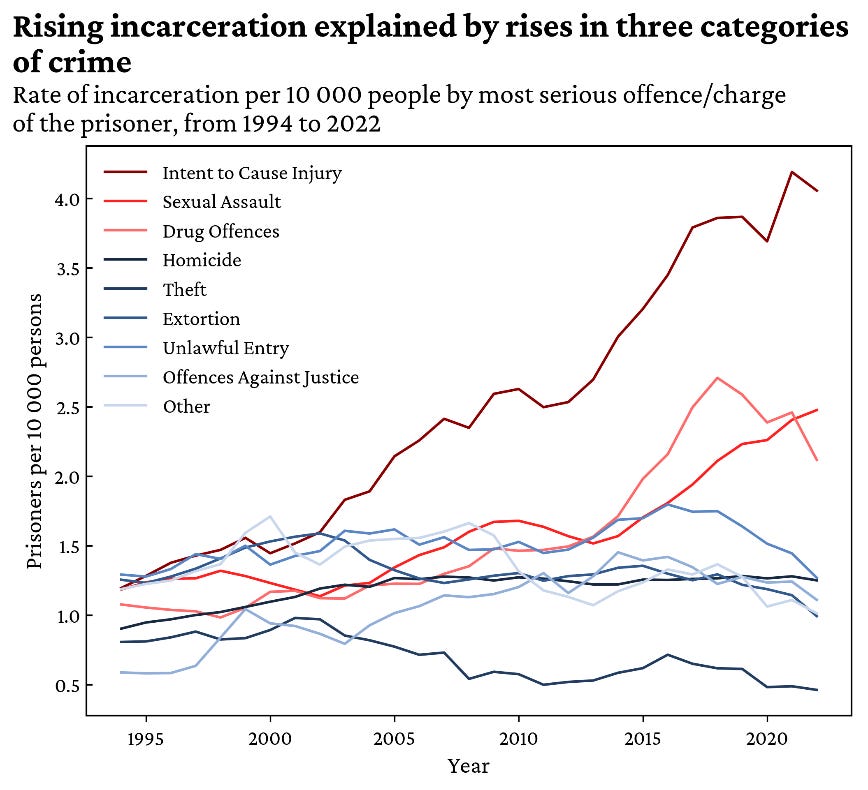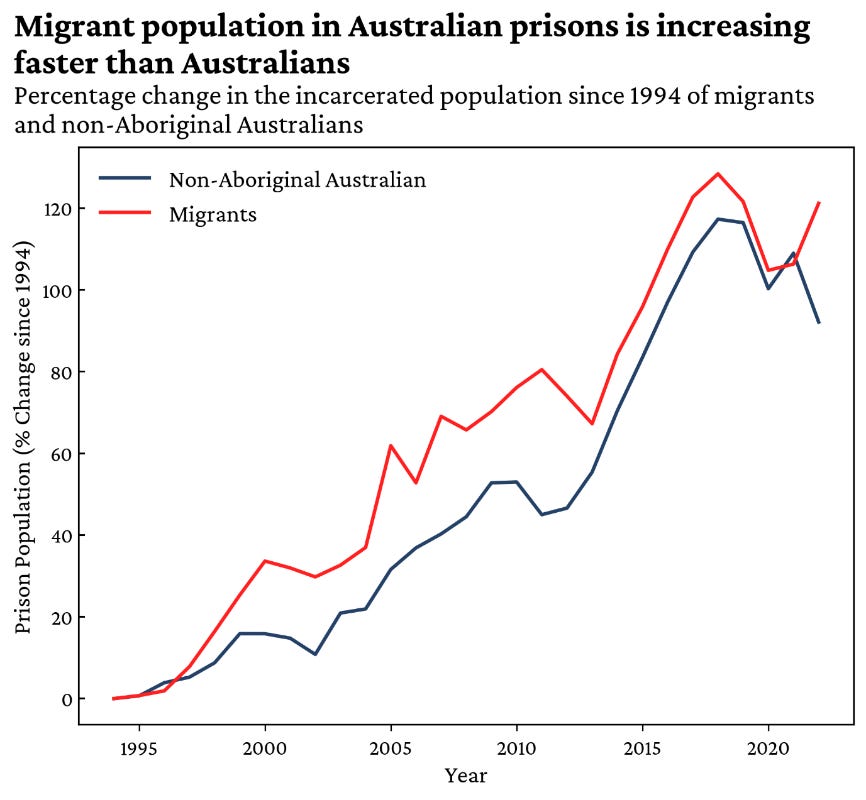Inside Australia’s Crime Wave
A statistical analysis of the trends and causes of Australia's growing crime problem
Written by Flynn Holman, find more of his content on 𝕏 @Flynn_Holman_
This week in a tragic turn of events 70 year old grandmother Vyleen White was carjacked in a supermarket carpark by a gang of Sudanese teens, when she handed over the keys to her car she was brutally stabbed to death anyway, in front of her 6 year old granddaughter. This attack was not impossible to foresee. For decades, and truly ever since our founding, Australians have pointed to the cruel and rampant crimes perpetrated in the third world, Africa in particular, and in the interest of Australians advocated for various programs of immigration restriction in order to protect our countrymen from becoming the victims of these crimes on Australian soil. Even the most mainstream of individuals voicing such criticisms such as current opposition leader Peter Dutton were labelled ‘racist’ and accused of possessing some ignorant prejudice against Africans for suggesting various immigrant populations in Australia have a crime problem. Today, an innocent 70 year old grandma would still be alive had we adopted these ‘racist’ stances.
Of course, the murder of Vyleen White is not a standalone incident or anomaly. To the casual observer, it is clear that crime, and in particular violent crime, is increasing, fuelled by the rising cost of living and uncontrolled immigration. School children are being targeted by violent criminals (SBS), young workers are being killed by customers (SKY) and businesses are being broken into periodically (News.com.au) and yet governments remain hesitant to implement tough-on-crime policies.
Causes of this latest crime wave have become contentious, with any reporting of the racial dimension labelled “racial profiling”, “fear mongering” and “racist” by sections of the Australian mainstream media. With the cost-of-living crisis, rising housing costs and now crime waves, Australia’s elite would seemingly rather sacrifice the jobs and savings, and even the lives, of everyday Australians than ever reduce immigration, the undeniable root cause of this degradation. How can government’s affect a better country for Australians if they refuse to address the issues head on? This latest crime wave and the subsequent lacklustre government responses will likely be important issues for the forthcoming 2024 Queensland state election and a key focus for former-police-officer-turned-politician Peter Dutton as he heads into a federal election in 2025.
The National Observer will not be deterred from confronting controversial issues as we seek to bring Australians the facts. Following on from our article statistically analysing White replacement in Australia published last year, the National Observer has once again in this article laid out in unflinching detail the key trends in recent national crime data, and explore who is driving this latest crime crisis.
Are we in a crime crisis?
Recent rises in crime, particularly in Queensland and Victoria, have been widely reported. With every assault and home invasion politicians are facing more pressure to address these acts. The general public is increasingly concerned with these rises in crime, and victims are beginning to take to the streets to demand the government intervene.
There is no doubt that incarceration rates have increased in recent years. Data on the prison population from 1994 to 2022 shows that the number of prisoners in Australian gaols has nearly doubled from 9.5 prisoners for every 10 000 people in 1994 to 17.1 prisoners for every 10 000 people in 2018. Whilst there has been a decline over the last few years, likely attributable to Covid-19 lockdowns during 2020 and 2021, the trend over the last 30 years has been one of increasing criminal offences.
Incarcerating a person in 2024 is not cheap. The Institute of Public Affairs estimated in 2023 that it costs $405 per prisoner per day to house a prisoner in Australia’s criminal justice system (IPA). This is a total expenditure of approximately $6 billion in 2023 alone. Increasing levels of incarceration are therefore not only a danger to Australian society, but they also impact the Australian taxpayer. In fact, the average Australian taxpayer is paying $114 more per year today, than if incarceration rates were at 1994 levels.
By breaking down the incarceration rate by crime category, some trends in crime over the last 28 years are revealed. Whilst most crimes are stagnant or trending down, alarmingly rates of sexual assaults, drug offences and acts with intent to cause injury (assaults, stalking, drugging) have more than doubled. This will come as no surprise to victims of these crimes from Cairns to Alice Springs and Melbourne, but it is a stark reminder that action needs to be taken in order to ensure that Australia remains a safe and moral nation.
So, what is driving this crime wave?
Aboriginal Offenders:
It is incredibly important to understand why crime in Australia is increasing, and by extension who is committing it. Unfortunately, willingness to name the perpetrators of certain types of crime will see your name dragged through the mud as a ‘racist’ and assorted other pejorative’s in the modern West. Yet, for those living near the hotspots, similarities among many of the perpetrators have become impossible to deny. Aboriginal crime has long plagued civil Australians, but recent media coverage of crime waves in Queensland and the Northern Territory has favoured language like “youth crime” and “juvenile offenders” over more apt descriptions of “Aboriginal youth.” Here we reveal the facts behind Aboriginal crime in Australia over recent decades.
Aboriginal incarceration rates are increasing significantly faster than other populations. From 1994 to 2022, the Aboriginal prison population grew by over 360%, while the non-Aboriginal Australian prison population peaked at 114% higher than 1994 in 2018, before shrinking over the last 5 years. The result of this is that Aboriginals now make up over 30% of prisoners in Australian gaols, despite representing only 4% of the general population, and are significant contributors to our growing crime issues in Australia.
A closer look at Aboriginal offenders leads to some alarming distinctions between Aboriginal crime and other offenders. 2022 prisoner data shows that Aboriginals are incarcerated at a higher rate than other races across ALL crime categories examined. Significantly in 2022, Aboriginals were 7 times more likely to commit homicide and 6 times more likely to commit sexual assault than non-Aboriginal Australian offenders. Perhaps most concerningly, Aboriginals were 22 times more likely to commit acts which are intended to cause injury, that is assaults, affray, stalking and other crimes of that nature. The types of crime where Aboriginals are most overrepresented – acts intended to cause injury and unlawful entry – are also those which have seen spikes in North Queensland and the Northern Territory. It is also worth noting that this data represents the most serious offence, and so each data point represents a unique prisoner, each potentially responsible for more than one of these crimes. Whilst data for 2023 is currently unavailable, the high Aboriginal population within these regions, combined with these high crime numbers, support the proposition that it is Aboriginal offenders which are driving the crime waves seen in Australian towns.
The common rebuttal to this conclusion is that Aboriginal overrepresentation in Australia’s criminal justice system is a result of systematic racial discrimination and racial profiling against Aboriginals. However, a simple look at the offender distribution over the last 30 years tells a different story. The following graph shows the percentage of Aboriginal (and non-Aboriginal) offenders in gaol for each crime out of the total Aboriginal (and non-Aboriginal) prison population. For most crimes the Aboriginal and non-Aboriginal proportion of offenders is not significantly different. For example, sexual assault offenders make up, on average, 10% of all Aboriginal offenders and 12% of non-Aboriginal offenders, an almost identical percentage of offenders. There are only two significant differences present in the data; non-Aboriginals have a far higher proportion of drug offences and Aboriginals have a higher proportion of acts intended to cause injury. This is entirely consistent with known crime increases in assaults committed by Aboriginals across Australia (as seen above) and therefore the overrepresentation in this category is attributable to increases in crimes committed, and not to police racial bias. The otherwise similar distributions of Aboriginal and non-Aboriginal offenders suggest no significant racial bias against Aboriginals across any other category of crime. Clearly the rises in intent to cause injury offences are attributable to increases in Aboriginal crime.
Deaths in Custody:
The final component of Aboriginal incarceration which is often discussed as evidence of racism in the criminal justice system is Aboriginal deaths in custody. Using data from the Australian Institute of Criminology on deaths in custody we have calculated the expected number of Aboriginal deaths in custody based on their proportion of the prison population and the number of non-Aboriginal deaths in custody. Highlighted in red are the years which actual Aboriginal deaths exceeded their expected level. As can be seen, 2005 was the last year in which Aboriginal deaths exceeded their expected level.
In fact, recent years have shown significantly fewer deaths than non-Aboriginal prisoners. Whilst we agree any death in custody is tragic, and effort should be made to prevent them, it is clear from the data that there is no Aboriginal deaths in custody “crisis”. This narrative is misinformation designed to divert attention from legitimate questions about the rises in Aboriginal crime which Australians are experiencing right now.
Migrant Prisoners:
From the Chinese counterfeiters on the Ballarat goldfields to the post-war crime waves, immigrants have a long history of fuelling crime in Australia. Today migrants make up nearly 1 in 5 prisoners in Australian gaols. Whilst, ethnicity data of prisoners is not currently recorded by any Australian state or territory, the ABS do provide country of birth data for prisoners in Australian gaols. In all but 2 years since 1994 (1996 and 2021), the migrant population in Australian gaols has shown a larger increase than the non-Aboriginal Australian population. Note that Covid-19 immigration restrictions likely reduced immigrants in Australian gaols in 2021, and this reduction is not an indication of an overall reduction in immigrant crime. In fact, with over half a million new migrant arrivals into Australia in 2022, the migrant prison population increased by 7% whilst the non-Aboriginal Australian population decreased by 5% over the same period. This rise is particularly concerning, with the continuing demographic replacement of White Australians, we can only expect these crime waves to worsen.
Breaking the data down by crime reveals stark regional trends which align with the increases observed in both drug offences and sexual assault over recent years. Migrants from Asia and the Middle East are strongly overrepresented in convicted drug criminals. Sixteen Vietnamese are imprisoned for every 10 000 Vietnamese immigrants, compared to just one imprisonment per 10 000 for immigrants from the United Kingdom. Such a stark difference between Anglo and Vietnamese immigrants suggests that a similar disparity would be seen between ethnically Vietnamese and Anglo Australian residents. Therefore, much of this rise in drug crime could be attributable to longstanding South-East Asian and Middle Eastern immigration into Australia.
Sudanese immigrants are drastically overrepresented in most crime classifications, highlighted by the fact that 42 in every 10 000 Sudanese immigrants are incarcerated for intent to cause injury crimes. Sudanese immigrants are 7.5 times more likely to commit homicides than Australians, 3.6 times more likely to commit sexual assault and 12.7 times more likely to commit extortion. Sudan itself is one of the most violent nations in the world, consistently ranked near the bottom of the Global Peace Index and this data suggests that Sudanese immigrants are bringing this pre-disposition to Australian shores. The left can call us racist, but as the recent stabbing of Vyleen White viewed in conjunction with the data shows that African crime gangs are a contributing factor to our current crime crisis.
Commentators would argue these huge crime statistics can be explained by the large youth component of the Sudanese population compared to the Australian population at large. As can be seen, the rate of incarceration of Sudanese far outnumbers many other migrant populations, which are similarly younger than the average Australian. Immigrants are bringing crime with them. Overrepresentation particularly in drug crimes, but also sexual assaults and acts intent to cause injury reveal a pattern of behaviour inconsistent with a civil Australian society. With ethnic data of Australian-born inmates unavailable, it is likely the crime rate of Australians would reduce by
accounting for 2nd and 3rd generation immigrants. Limiting immigration is the only viable option to curbing high rates of immigrant crime in our communities.
The Left Ignores the Facts
Aboriginals and immigrants make up nearly 50% of Australia’s incarcerated population. Aboriginal crime has increased by over 350% in the last thirty years. Immigration levels are at record highs. These are all facts that policy makers conveniently ignore as they propose weak laws to curb Australia’s crime problem. As the voting power of these immigrant populations increases, and governments further refuse to address the causes of these rises in crime, our streets will become less and less safe. White Australians are demographically replaced, and our prisons are being filled with imported criminals.
So ask yourself, are we truly a successful multicultural nation when drugged up criminals target Australian children, when assaults in our streets are rising exponentially, w hen families are hiding from intruders in their own homes and when grandmas are being stabbed for their car keys in front of their 6 year old granddaughter?
I believe anyone working impartially in Australia’s interests must reply with a decisive ‘no’.











